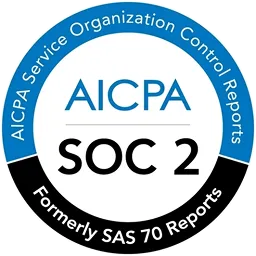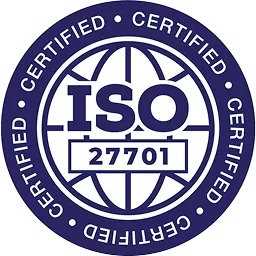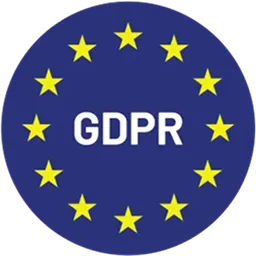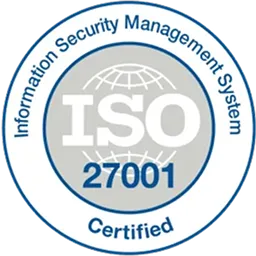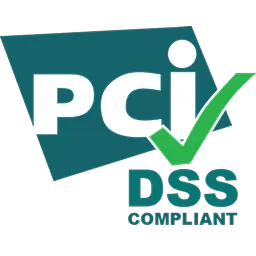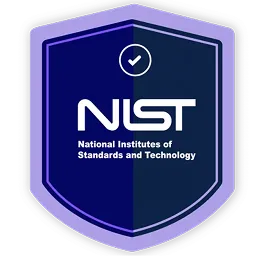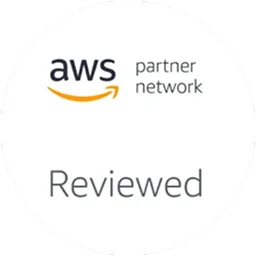The compliance landscape continually evolves, driven by new risks, technological advancements, and regulation changes. Therefore, it is essential to review key compliance statistics and insights. These insights will help you improve your compliance practices and efficiently overcome challenges.
Navigating the world of compliance is an ongoing challenge that requires constant vigilance and adaptability. With each passing year, organizations must contend with an evolving landscape of regulations and standards across various frameworks and industries. Thus, staying compliant isn't just a matter of financial investment; it also demands a keen awareness of emerging changes and their implications.
Furthermore, the rules and risks associated with security compliance differ significantly globally. Thus, understanding the current state of compliance in 2024 is essential for businesses to navigate these complexities effectively and maintain their competitive edge.
To help you stay informed and ahead of the curve, we've curated a comprehensive list of the top compliance statistics for 2024. We will delve into the key compliance trends, the significance of adherence in different industries, and the broader implications for organizations striving to meet regulatory requirements.
The Current Compliance Statistics Landscape
The compliance landscape has evolved significantly, with new priorities, risks, technologies, and regulations adding to its complexity. Here's a snapshot of the current compliance statistics, which have become more intricate in recent years, offering valuable data that highlights the shifts, improvements, and ongoing efforts within the industry.
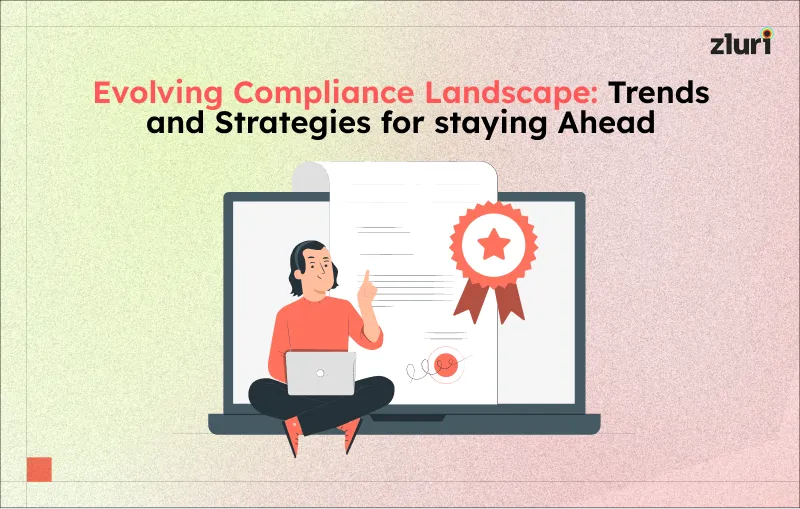
- Shift to Strategic Compliance: Over the past two to three years, 70% of corporate risk and compliance professionals have noticed a significant shift from basic check-the-box compliance to a more strategic approach. This evolution reflects a deeper integration of compliance within broader business strategies, focusing on meeting regulatory requirements and leveraging compliance as a competitive advantage.
- Critical Role in Decision-Making: A substantial 83% of risk and compliance professionals believe that ensuring their organization remains compliant with all relevant laws, policies, and regulations is essential when making decisions. This underscores the growing recognition of compliance as a fundamental organizational strategy and governance component.
- Business Advisory Functions: Notably, 80% of corporate risk and compliance professionals agree that their organizations now view risk and compliance as valuable business advisory functions. Furthermore, 74% of these professionals affirm that risk and compliance requirements enable, support, and enhance business activities, demonstrating the integral role of compliance in promoting business growth and sustainability.
- Increased Investment in Compliance: According to 60% of executives, their organizations invest more time and resources into complying with laws and regulations. However, there is a disparity in perception, as only 31% of consumers believe the same. This gap highlights the need for better communication and transparency regarding compliance efforts.
- Multiple Frameworks: In 2023, nearly 70% of service organizations reported the necessity to demonstrate compliance or conformity to at least six different frameworks covering information security and data privacy. This statistic indicates the increasing complexity and breadth of regulatory requirements that organizations must navigate.
- Multiple Compliance Systems: 59% of security and IT leaders indicate that their organizations operate multiple systems that must adhere to various compliance requirements. This multi-system approach reflects the intricate nature of modern compliance landscapes, necessitating robust management and integration strategies.
- Improved Risk Approaches: Over the past 12 months, 40% of surveyed business and risk leaders stated that their organizations had improved their approach to risk management to achieve stronger compliance with regulatory standards. This number jumps to 81% among the top-performing 5% of organizations, showcasing the link between enhanced risk management practices and superior organizational performance.
- Effective Cyber Regulations: In 2023, 73% of organizational leaders agreed that cyber and privacy regulations effectively reduce cyber risks. This is a significant increase from 2022, when only 39% held this view, indicating growing confidence in the regulatory measures aimed at mitigating cyber threats.
- Economic Impact of U.S. Regulation: If U.S. regulation were considered a country, it would rank as the world's eighth-largest economy. This staggering statistic highlights regulatory frameworks' extensive influence and financial impact on the global stage.
- Regulatory Costs: U.S. businesses incur an average cost of $10,000 per employee to comply with regulations. This figure underscores the significant financial burden regulatory compliance imposes on organizations, particularly on their operational budgets.
- Data Protection Frameworks: A striking 84% of security and IT professionals state that adherence to data protection frameworks such as GDPR and CCPA is mandatory for their industries. This widespread requirement emphasizes the critical importance of data privacy and protection in today's regulatory environment.
- Location of Compliance Functions: When risk and compliance professionals were asked where their organization's compliance function is housed, the responses were diverse:
- 22% said it is an independent function reporting to the CEO and/or board of directors,
- 18% placed it within IT/data security/data privacy,
- Another 18% said it is split across multiple departments,
- 17% located within the legal department,
- 9% within human resources, and 6% within the internal audit department.
This distribution illustrates the varied organizational structures supporting compliance.
- Key Compliance Involvement Areas: Compliance officers identified the top three areas where compliance is actively involved: implementing a demonstrably compliant culture (58%), setting risk appetite (51%), and assessing the effectiveness of corporate governance arrangements (48%). These areas highlight the proactive role of compliance in shaping organizational culture and governance.
- Ethical Culture: Ensuring an ethical culture of compliance is a high priority, with 76% of risk and compliance professionals considering it essential in decision-making processes. This focus reflects the increasing emphasis on ethics and integrity within corporate governance.
- Primary Tasks: Risk and compliance professionals spend most of their time on two key activities: identifying and assessing risk (56%) and monitoring compliance (52%). These tasks are fundamental to maintaining an effective compliance program.
- Highest Risk Areas: Chief audit executives have identified the top five highest-risk areas as cybersecurity (65%), IT (51%), third-party relationships (41%), compliance/regulatory issues (41%), and operational risks (33%). These areas represent organizations' most significant challenges in managing risk and compliance.
- Planned Training Topics: 60% of risk and compliance professionals indicate that cybersecurity will be a primary training topic over the next two to three years. This focus on cybersecurity training reflects its critical importance in safeguarding organizational assets and maintaining compliance.
Consequences of Non-Compliance Statistics
Implementing a robust compliance program can seem overwhelming, but the consequences of neglecting compliance are far more severe. The following statistics highlight the significant risks associated with inadequate compliance management practices:
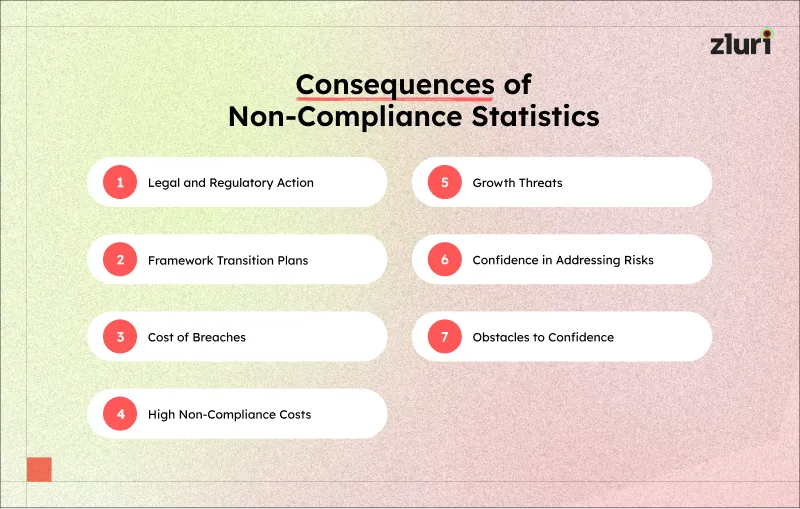
1. Legal and Regulatory Action
In the past three years, 19% of risk and compliance professionals reported experiencing legal or regulatory action against their organization by a governing body. This issue ranks as the third most common compliance problem, illustrating how lapses in compliance can lead to serious legal consequences and regulatory scrutiny (Navex Global's 2023 Definitive Risk & Compliance Benchmark Report).
2. Framework Transition Plans
A significant 77% of organizations have plans to transition to the next revision of applicable compliance frameworks within the allowed periods. This demonstrates a strong awareness of the need to stay current with evolving regulations. However, 21% of organizations plan to wait until a required audit or external party findings before taking any action. This delay in proactive compliance measures can leave organizations vulnerable to penalties and operational disruptions (Coalfire Compliance Report 2023).
3. Cost of Breaches
Data breaches are substantially more expensive when non-compliance is a factor. On average, breaches cost nearly $220,000 more if non-compliance with regulations was involved. This stark increase highlights the financial impact of failing to adhere to regulatory standards, underscoring the importance of comprehensive compliance programs to mitigate these costs (IBM's Cost of a Data Breach Report, 2023).
4. High Non-Compliance Costs
Organizations with a high level of non-compliance face severe financial repercussions. The average data breach cost for these organizations is USD 5.05 million, representing a 12.6% increase compared to the average breach cost. This substantial financial burden emphasizes the critical need for stringent compliance measures to avoid such costly incidents (IBM's Cost of a Data Breach Report 2023).
5. Growth Threats
Compliance and regulatory risk are seen as major threats to company growth. Specifically, 35% of risk executives identified these risks as the greatest threats to their company's ability to drive growth. Similarly, another 35% cited cyber or information risk as a significant threat. These insights reflect the pervasive impact of compliance and regulatory issues on organizational strategy and success (2022 PwC Pulse Survey of CROs and Risk Management Leaders).
6. Confidence in Addressing Risks
Despite the challenges, a majority of corporate risk and compliance professionals—three out of five—express confidence in their ability to address compliance risks. This confidence suggests that many organizations are taking proactive steps to manage compliance effectively, although there remains room for improvement (2023 Thomson Reuters Risk & Compliance Survey Report).
7. Obstacles to Confidence
Several factors undermine confidence in managing compliance risks. The top obstacles cited by compliance teams include a lack of knowledgeable personnel, inadequate resources, and poor company culture. These barriers highlight the need for organizations to invest in training, resources, and a supportive culture to strengthen their compliance programs and address risks more effectively (2023 Thomson Reuters Risk & Compliance Survey Report).
In summary, these statistics underscore the critical importance of robust compliance programs. The risks of non-compliance extend beyond financial costs to include legal actions, regulatory penalties, and threats to organizational growth. Addressing these risks requires a proactive approach, continuous investment in resources and training, and fostering a culture of compliance.
Usage and Effectiveness of Compliance Tools
Integrating new technologies and tools has become crucial for streamlining processes and enhancing security in the ever-evolving compliance landscape. By proactively incorporating these innovations into compliance strategies, companies save costs and bolster their overall security posture.
- Anticipated Technology Spend Increases: Compliance leaders foresee technology as one of the areas with the highest spending increases this year, highlighting the growing importance of technological solutions in compliance management.
- Benefits of Streamlining with Technology: Nearly two-thirds (65%) of corporate risk and compliance professionals believe that leveraging technology to automate manual processes can reduce the complexity and cost associated with risk and compliance.
- Adoption of Technology for Regulatory Compliance: 35% of risk and compliance professionals are adopting technology solutions to meet regulatory requirements, reflecting the industry's shift towards tech-driven compliance practices.
- Increase in Outsourcing Compliance Functions: The percentage of organizations outsourcing some or all of their compliance functionality has risen to 38%, up from 30% in the previous year, indicating a growing reliance on external expertise for compliance management.
- Automation and Technology Adoption: Only 5% of risk and compliance professionals report that their organizations do not use automation and technology solutions for their risk and compliance programs, underlining the widespread adoption of technological tools in compliance management.
- Top Functions Benefiting from Technology: According to firms, the top five risk and compliance functions benefiting from technology include vendor oversight (54%), marketing reviews (41%), compliance policy/activity tracking (41%), trade surveillance (32%), and regulatory reporting (24%).
- Reasons for Adopting Automation Solutions: The primary reasons for adopting new risk and compliance automation and technology solutions include risk reduction (46%) and meeting regulatory requirements (38%), indicating a dual focus on enhancing security and ensuring compliance.
- Additional Reasons for Adoption: Roughly 1 in 5 respondents cite reasons such as automating practices and procedures (24%), streamlining workflows/reducing redundancy (22%), reducing costs (21%), and saving time on managing risk and compliance tasks (20%) for adopting automation and technology solutions.
- Improving Security Posture with Technology: Security professionals prioritize upgrading tools (67%) to improve their company's security posture. However, integration difficulties, lack of expertise, and tool management challenges hinder these efforts.
- AI and ML Adoption to Combat Financial Crime: Amid the pandemic, 43% of those under extreme pressure to increase revenue express a desire to deploy AI and ML to combat financial crime in the future.
- Top Use Cases of AI in UK Companies: Risk assessment and analytics (25%), data analytics and reporting (23%), workflow and document drafting (21%), fraud detection and prevention (19%), compliance training and education (15%), and monitoring regulatory changes (13%) are the top use cases of AI in UK companies.
- Security AI and Automation Adoption: A majority (61%) of organizations employ some level of security AI and automation, with 28% extensively using it in their operations. Extensive use of these capabilities correlates with lower data breach costs and faster breach identification and containment.
Third-Party Compliance Metrics
Managing compliance extends beyond internal operations to include the third parties your organization engages with. Third-party compliance issues can introduce significant risks. Here are some key insights into third-party risk management:
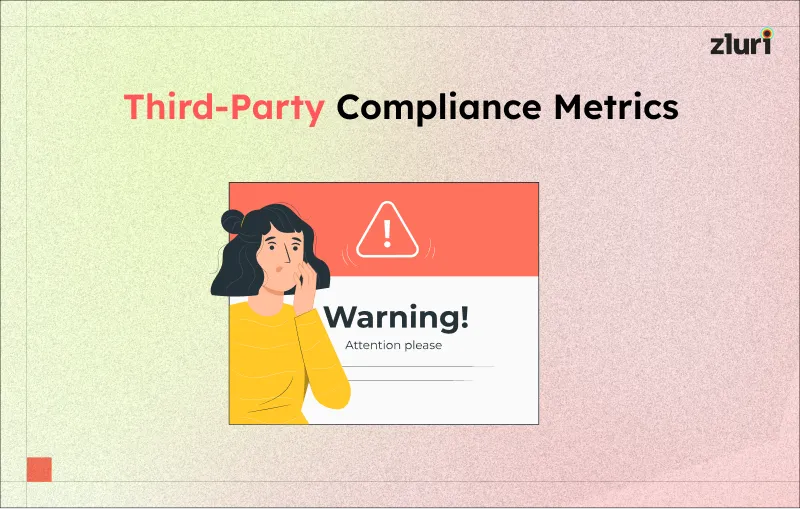
- Top Challenge: Vendor Responsiveness: 58% of compliance teams identify gauging vendor responsiveness as their biggest challenge in managing third-party risk (ACA).
- Tracking Third-Party Compliance: Nearly half (48%) of organizations report difficulties in tracking third-party compliance, highlighting the complexity of ensuring that external partners adhere to required standards (MetricStream).
- Incomplete Third-Party Lists: 48% of organizations do not have a comprehensive list of all third parties with access to their network, posing significant security risks.
- Vendor Support Issues: 39% of businesses cite issues with vendor support as a key reason for enhancing their security frameworks, indicating the critical role of vendor cooperation in maintaining security (Ponemon Institute).
- Increase in Cyberattacks: Cyberattacks targeting third parties have risen from 44% to 49% over the past year, underscoring the growing threat landscape associated with third-party engagements.
- Compliance Departments Oversee Third-Party Risk: In 34% of organizations, compliance departments are responsible for overseeing all third-party risk management, reflecting the importance of a centralized approach to managing these risks (Gartner).
- Services Outside Core Operations: 66% of legal and compliance leaders note that third parties provide services beyond their business’s core operational model, which can complicate compliance efforts.
- Efforts in Due Diligence: A substantial 73% of risk identification efforts are dedicated to due diligence and recertification, while only 27% focus on identifying risks during the ongoing relationship, suggesting a need for more continuous monitoring.
- Top Priority: Managing vendor relationships and third-party risk is the top priority for 9% of businesses, indicating a growing recognition of the importance of this aspect of compliance (Clausematch).
- Outsourcing Compliance Functions: 34% of organizations outsource at least some of their compliance functions, leveraging external expertise to manage these complex requirements.
- Lack of Partner Information: 52% of compliance experts claim that insufficient data and information about partners expose businesses to third-party risks, highlighting the need for better data collection and analysis (Accenture).
Framework-Specific Compliance Data
Each compliance framework has distinct requirements and trends. Here’s a detailed look at some of the most significant frameworks and their recent compliance statistics.
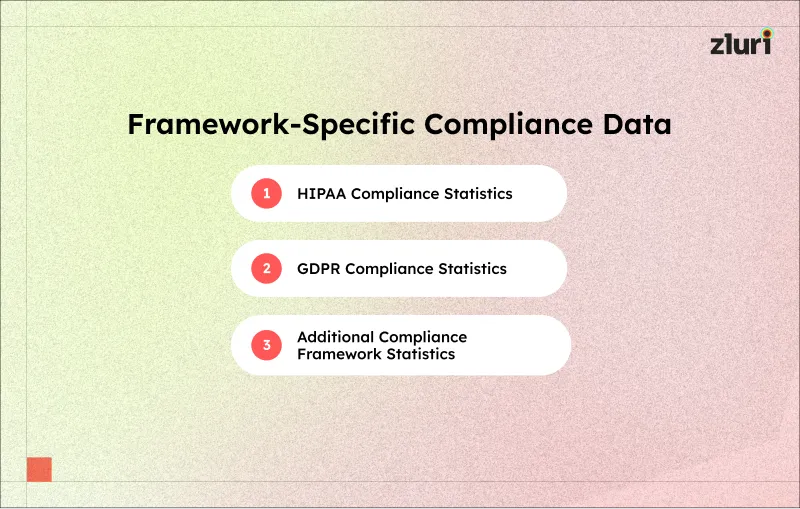
HIPAA Compliance Statistics
HIPAA (Health Insurance Portability and Accountability Act) is crucial for healthcare entities to protect sensitive Patient Health Information (PHI). Below are some key statistics related to HIPAA compliance:
- Healthcare Data Breaches: Between 2009 and 2022, there were 5,150 healthcare data breaches involving 500 or more records, resulting in the exposure of over 382 million medical records.
- Daily Breach Reports: In 2022, an average of 1.94 healthcare data breaches involving 500 or more records were reported daily.
- ASETT Complaints: In the first quarter of 2023, 58% of complaints submitted through the Administrative Simplification Enforcement and Testing Tool (ASETT) did not violate HIPAA rules.
- Leading Cause of Breaches: Hacking is the predominant cause of healthcare data breaches, surpassing theft, impermissible disclosures, and ransomware attacks.
- Record Year for Enforcement: 2022 saw a record number of HIPAA enforcement actions, with over 222 penalties issued (The HIPAA Journal).
- Penalties on Small Practices: In 2022, 55% of the financial penalties were imposed by the Office of Civil Rights on small practices.
- Penalty Ranges: HIPAA violations can result in penalties ranging from $100 to a maximum of $25,000 per violation category annually.
GDPR Compliance Statistics
The General Data Protection Regulation (GDPR) is a framework established by the European Union to protect the personal data of EU citizens. It applies to companies operating within the EU or handling data of EU citizens. Key GDPR compliance statistics include:
- Increase in Fines: The total value of GDPR fines issued in 2022 was 50% higher than in 2021 (DLA Piper).
- Total Fines Since Implementation: From the implementation of GDPR on May 25, 2018, to January 10, 2023, total fines amounted to 2.92 billion euros (approximately $3.1 billion).
- Changing Email Providers: To comply with GDPR standards, 20% of compliance staff reported changing their email providers (Business 2 Community).
- Difficulty in Compliance: 90% of compliance professionals consider GDPR compliance the most challenging to achieve (Globalscape).
Additional Compliance Framework Statistics
Compliance with international standards and payment data security is increasingly important. Here are some insights into ISO 27001 and PCI DSS compliance:
- PCI DSS Fines: In the U.S., fines for non-compliance with the Payment Card Industry Data Security Standard (PCI DSS) can range from $5,000 to $100,000 per month until the issue is resolved (VikingCloud).
- PCI Compliance Rates: In 2020, 43.4% of organizations achieved and maintained PCI compliance (Verizon).
- ISO Standards: The International Organization for Standardization (ISO) has established 24,780 international compliance standards, with 1,412 new standards added in 2022.
- Global Representation: ISO members are represented in 168 countries, emphasizing the global reach and importance of these standards.
These statistics highlight the evolving landscape of compliance across different frameworks, emphasizing the ongoing challenges and efforts required to maintain adherence to regulatory requirements.
Projected Compliance Trends For 2024
In light of the ongoing disruptions from the pandemic, businesses are rethinking their operational resilience. The need for a well-managed risk and compliance program has become increasingly evident. Here are some key compliance trends predicted by industry experts for the coming year.
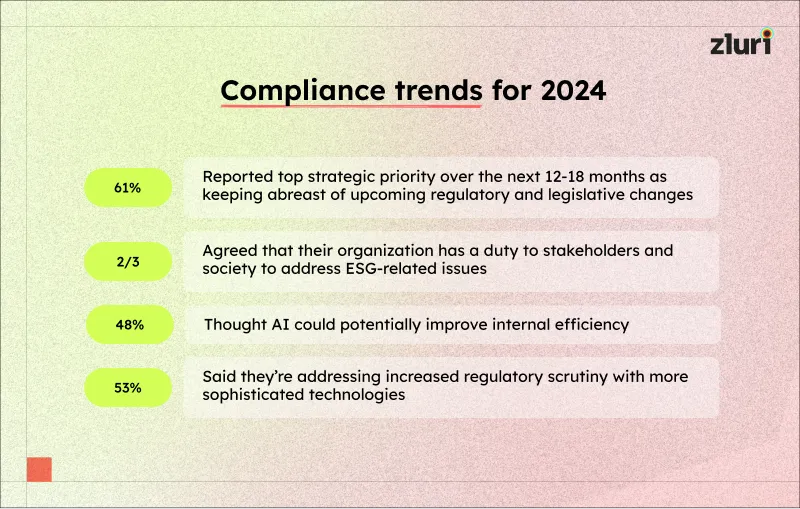
Keeping Up with Regulatory Changes
- Strategic Priority: 61% of corporate risk and compliance professionals have identified staying abreast of upcoming regulatory and legislative changes as their top strategic priority over the next 12 to 18 months (2023 Thomson Reuters Risk & Compliance Survey Report).
Adoption of AI in Compliance
- AI Integration: Nearly half (48%) of surveyed risk and compliance professionals believe that AI could enhance internal efficiency, and 35% think it will help keep up with regulatory changes (2023 Thomson Reuters Risk & Compliance Survey Report).
Transition to Updated Frameworks
- Framework Upgrades: 77% of security and IT leaders plan to transition to updated frameworks like PCI DSS 4.0 within the next 18 months (Coalfire Compliance Report 2023).
Focus on Data Privacy and IT Security
- Data Privacy and IT Security: Over half of compliance and risk professionals (53% and 52%, respectively) consider managing data privacy and IT/information security risk as absolutely essential. The interdependence between IT and Compliance is expected to increase (Navex Global's 2023 Definitive Risk & Compliance Benchmark Report).
Cyber Resilience Involvement
- Cyber Resilience: 45% of companies expect increased involvement of compliance in cyber resilience efforts in the coming years (Thomson Reuters Cost of Compliance Report 2023).
Zero Trust Initiatives
- Zero Trust Security: 78% of companies globally have prioritized zero trust, and nearly 90% are working on a zero trust initiative (Okta's State of Zero Trust Security 2021 Report).
Insourcing Compliance Work
- Insourcing Trends: 63% of corporate risk and compliance professionals report increased insourcing of compliance work over the past two years, with 39% confirming a yearly increase in insourcing (2023 Thomson Reuters Risk & Compliance Survey Report).
Growth of Compliance Teams
- Team Expansion: 33% of respondents predict growth in their compliance teams over the next 12 months, slightly down from 35% in 20222.
Rising Costs of Compliance Officers
- Cost of Compliance Officers: 61% of respondents expect the cost of senior compliance officers to increase, with 51% anticipating a slight increase and 10% expecting a significant rise. This is compared to 67% who expected increases in 2022 .
Specialization and Technological Sophistication
- Specialization and Tech Use: 57% of corporate risk and compliance professionals report more specialized roles within their companies, and 53% are addressing increased regulatory scrutiny with more sophisticated technologies.
Increased Spending on Technology
- Technology Investment: Executives plan to increase spending on data analytics (75%), process automation (74%), and technologies supporting risk detection and monitoring (72%) (PwC's 2022 Global Risk Survey).
Personal Liability Concerns
- Personal Liability: Nearly half (49%) of survey respondents expect the personal liability of compliance professionals to increase over the next 12 months, with 13% anticipating a significant increase.
Tracking Regulatory Developments
- Regtech Solutions: 62% of compliance officers spend between 1 and 7 hours per week tracking and analyzing regulatory developments, down from 73% in 2022, likely due to increased use of regtech solutions. This trend is expected to continue.
Key Compliance Issues
- Top Compliance Issues: In a survey of 1,300 compliance and risk professionals, data privacy, protection, and security, along with regulatory compliance, were ranked as the most important compliance issues (Navex Global's 2023 Definitive Risk & Compliance Benchmark Report).
ESG Transparency and Reporting
- ESG Reporting: 21% of risk and compliance professionals cited regulatory or stakeholder demand for ESG transparency and reporting as a key compliance issue experienced in the past three years, second only to data breaches.
Growing Importance of ESG Compliance
- ESG Compliance: ESG compliance is becoming increasingly important as interest from consumers, employees, and executives grows. According to PwC:
- 91% of business leaders believe their company has a responsibility to act on ESG issues.
- 83% of consumers think companies should actively shape ESG best practices.
- 86% of employees prefer to support or work for companies that care about the same issues they do.
- 76% of consumers said they would stop supporting companies that treat employees, communities, and the environment poorly (PwC's 2021 Consumer Intelligence Series survey on ESG).
- Stakeholder and Societal Duty: Two-thirds of corporate risk and compliance professionals agree that their organization has a duty to stakeholders and society to address ESG-related issues. Nearly as many (62%) consider ESG-related risks, regulatory, and compliance factors important in organizational decision-making.
- Staying Updated on ESG: 77% of corporate risk and compliance professionals find it important or very important to stay updated on the latest ESG developments through various channels such as email newsletters and industry events.
These trends highlight the dynamic nature of the compliance landscape, emphasizing the importance of staying informed and proactive in managing compliance requirements.
Key Takeaways for Compliance in 2024
In conclusion, the compliance landscape for 2024 is marked by ongoing evolution and increasing complexity. Staying informed and proactive is paramount as organizations continue to navigate regulatory changes, technological advancements, and emerging risks. The trends and statistics outlined provide valuable insights into the shifting priorities and challenges facing compliance professionals across various industries.
Further, organizations need to leverage their technology and best practices to enhance efficiency and effectiveness. IT & Security teams can use tools like Zluri's access review solution to offer valuable support, helping organizations streamline compliance processes, improve risk management, and ensure regulatory adherence.
The platform offers a detailed audit trail of all access review activities, proving invaluable during audits for regulations like GDPR, HIPAA, SOC 2, PCI DSS, and CCPA. This tool enables you to demonstrate compliance effectively, allowing for the quick generation of reports and evidence to satisfy auditors and easing the burden of compliance documentation.
By embracing these tools and staying abreast of emerging trends, organizations can position themselves to navigate the complexities of compliance effectively and safeguard their reputation, data, and operations in the years ahead.









.svg)



